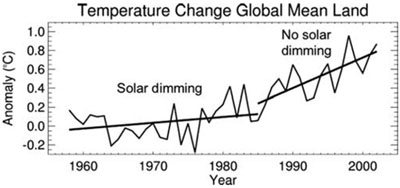What happened to greenhouse warming during mid-century cooling?
Posted on 3 July 2010 by John Cook
A few weeks back while researching global brightening, I came across a gem of a paper: Impact of Global brightening and dimming on global warming (Wild et al 2007). The paper examines temperature trends over the second half of the 20th Century, including the cooling period in the middle of the century. From the 1950s to early 1980s, while CO2 levels were rising, global temperatures cooled slightly. How can this be if CO2 causes warming? Wild 2007 found there was greenhouse warming during this cooling period and they find it in an interesting place...
The paper looks at trends in the amount of sunlight reaching the ground over the latter 20th century. Various factors can affect how much sunlight gets through to the Earth's surface, with the amount of aerosols in the atmosphere being the main contributor. And of course, the amount of sunlight reaching the surface will have an effect on global temperatures. Wild 2007 attempts to disentangle just how much contribution this surface dimming and brightening has on global temperature.
They start by looking at measurements of surface radiation from 1958 (when widespread measurements began). They find a period of "global dimming" from 1958 to 1990 where surface radiation fell. Afterwards, the dimming levels off and transitions to slight brightening from 1985 to 2002. While the warming during the period of solar dimming is moderate, the warming is more rapid in the last two decades where dimming was no more present.

Temperature change over global land surfaces from 1958 to 2002.
How much does global dimming and brightening contribute to the temperature trends. To disentangle the effects of dimming and brightening from greenhouse warming, Wild digs a little deeper into the temperature record by looking at the daily temperature cycle. Sunlight affects the daily maximum temperature more than the nightly minimum, which is affected more by the greenhouse effect. What they find is from 1958 to 1985, during global dimming, the maximum daytime temperature falls. This makes sense as less sunlight is reaching and warming the Earth's surface. The interesting result is that over this period, the nighttime minimum temperature increases. While global dimming was cooling temperatures in the daytime, the increased greenhouse effect was warming in the nighttime.
From 1985 to 2002, the warming trend during the daytime increases significantly and almost catches up to the nighttime warming trend (almost but not quite). This is consistent with the surface radiation measurements which find global dimming levels off or transitions to brightening in the mid 1980s. Global dimming masked greenhouse warming until the 1980s. Once the atmosphere cleared and the dimming was removed, global warming came into its own.
Does this mean global brightening could be responsible for global warming? Not quite. While there has been some global brightening since 1985, the amount of sunlight hitting the Earth hasn't reached 1960 levels yet. Sunlight has fallen since 1960 while global temperatures have risen 0.8°C. The daily temperature cycle indicates its greenhouse warming that has driven the warming. Yet another human fingerprint!
Where did CO2 warming go during mid-century cooling? Global dimming caused by pollution masked the increased greenhouse effect. Nevertheless, the CO2 warming was still percolating away while we were sleeping.































 Arguments
Arguments






























Climate scientists also argue this point. See CO2 is not the only driver of climate to discuss this point further.
"That's why 15 years of no warming is a problem for CO2 theory."
I'm guessing this is refering to the skeptic argument: "Phil Jones said no warming since 1995". This argument is analysed in detail - please continue any discussion of that argument at the relevant page.